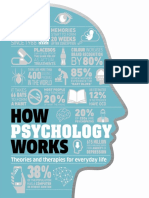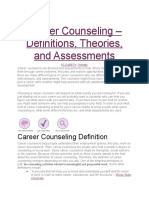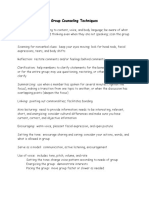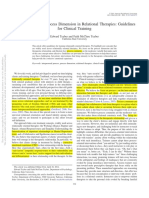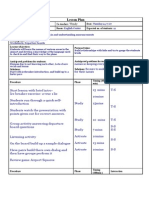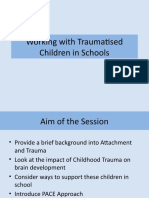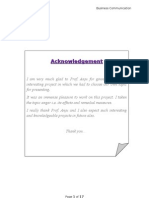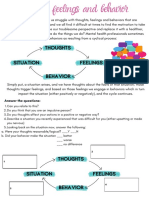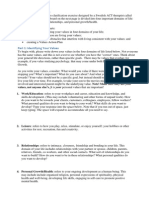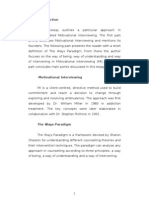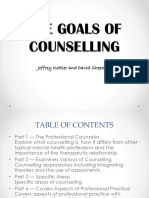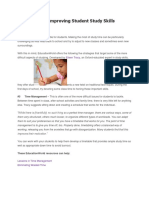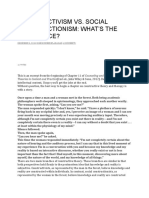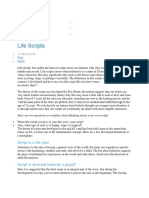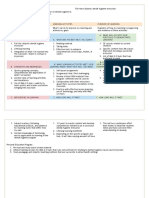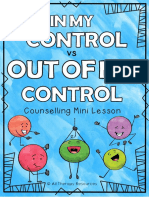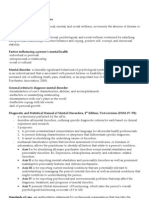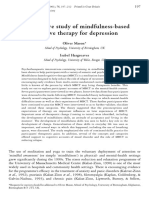What Is Psychotherapy 15 Techniques and Exercises
What Is Psychotherapy 15 Techniques and Exercises
Uploaded by
Mihaela VădeanuCopyright:
Available Formats
What Is Psychotherapy 15 Techniques and Exercises
What Is Psychotherapy 15 Techniques and Exercises
Uploaded by
Mihaela VădeanuOriginal Description:
Original Title
Copyright
Available Formats
Share this document
Did you find this document useful?
Is this content inappropriate?
Copyright:
Available Formats
What Is Psychotherapy 15 Techniques and Exercises
What Is Psychotherapy 15 Techniques and Exercises
Uploaded by
Mihaela VădeanuCopyright:
Available Formats
What is Psychotherapy: 15 Techniques and
Exercises (+PDF)
15 NOV 2017
JOAQUÍN SELVA
11 COMMENTS
SOURCE>https://positivepsychologyprogram.com/psychotherapy/
Last Updated on August 17, 2018
Psychotherapy is a type of treatment for a variety of mental disorders that has
been used in psychology for decades.
This article will cover what psychotherapy is and how it can benefit people
with various disorders.
This article will also discuss some ways that psychotherapists can improve
their own practice for the betterment of their clients.
This article contains:
What is Psychotherapy? A definition
5 Psychotherapy Techniques, Tools & Exercises
How to Deal with Resistance in Psychotherapy: Techniques for Therapists
The 10 Best Psychotherapy Interventions
What is the Best Psychotherapy Counseling Treatment
A Take Home Message
References
The Positive Psychology Toolkit
What is Psychotherapy? A definition
According to the American Psychological Association (APA), psychotherapy
can be defined as a “collaborative treatment … between an individual and a
psychologist” where the psychologist uses “scientifically validated procedures
to help people develop healthier, more effective habits“. For a more in-depth
discussion of what psychotherapy is and how it’s used, consult this PDF from
the Southern California Psychiatric Society.
For our purposes, we can define psychotherapy as a psychological treatment
for a variety of mental health disorders that may or may not be delivered in
concert with pharmaceutical treatment.
5 Psychotherapy Techniques, Tools & Exercises
One recent paper laid out a generalized approach that psychotherapists
should take to lead successful sessions (Yager & Feinstein, 2017). This
approach is broken up into four steps:
Relating: This includes respecting the patient’s self-esteem and struggles, as
well as being kind.
Exploring: This includes paying attention to what a client says (as well as
what they don’t say) and their body language, as well as asking questions
to better understand the client and clear up contradictions.
Explaining: This includes considering how the client’s and the
therapist’s cognitive biases may be shaping the session, as well as
considering any other factors (sociological, interpersonal, developmental,
etc.) that could shape the client’s thinking, then finally ask the client
whether or not they agree with your hunches and conclusions.
Intervening: This includes presenting one’s interpretations to the client so
they can agree or disagree with them, not enabling the client’s destructive
or dishonest behaviors, and teaching the client ways to deal with their
issues (such as coping skills).
Another issue with psychotherapy is that clinicians generally underestimate the
number of clients who leave treatment with no benefit, or at risk of
deterioration (Lambert, 2017). The first step to correcting this issue is to make
therapists aware of the discrepancy between how they think treatment is
progressing and how the client is actually progressing.
One way to do this is the Outcome Questionnaire-45 (OQ-45), which is a 45-
question self-assessment that clients can complete at the end of each session
to track their therapeutic progress. If therapists offer this option to clients, they
can more quickly identify clients in need of modified treatment plans.
There is also a Youth Outcome Questionnaire-30 (Y-OQ-30) for children and
adolescents, which can either be completed by the client or their parent(s). By
using these tools, psychotherapists can ensure their treatment plans are
effective and modify them if they are not.
For more information on how to be an effective psychotherapist, consult this
PDF from the American Psychological Association.
How to Deal with Resistance in Psychotherapy: Techniques for
Therapists
One way to deal with resistance in psychotherapy is for the therapist to ask
the client for feedback at the end of each session, and attempt to modify their
treatment plan in response to that feedback (Esmiol-Wilson et al., 2017). For
example, certain clients whose feedback was solicited expressed that their
therapist did not understand their situations because of their own privilege as
a therapist. The therapist was then able to recognize this and incorporate it
into their treatment so that they could deal with their client from a more honest
and open perspective.
Another study looking at resistance in psychotherapy focused specifically on
in-session distress (Yasky et al., 2016). These researchers had clients
complete post-session questionnaires which asked them to identify any in-
session distress they experienced. From there, the therapists were more
careful to monitor in-session distress and discussed this distress with their
client when they felt it was becoming an issue. When in-session distress was
identified and discussed, clients completed more therapy sessions and
achieved better post-therapy outcomes.
This idea is reinforced in the description of a case study of a man who sought
therapy for anger issues at the behest of his wife (Dowd, 2016). When the
therapist was encountering extreme resistance from the client, she briefly
stopped the session and (politely) confronted him about his resistance,
allowing the client to feel that he was being listened to. From there, the
therapist gave the client more control by allowing him to structure the session
himself, at which point he became less guarded and was eventually able to
resolve some of his issues (with multiple psychotherapy sessions).
The common thread in all three of these papers is the idea of adaptability. In
all cases, therapists encountered resistance when they ran the sessions by
the book and somewhat rigidly. By getting direct feedback from the client, the
therapists were able to modify their treatment plans to address the client’s
concerns, and from there they encountered less resistance.
Since psychotherapy is supposed to be an individualized process, the ability
to adapt a treatment plan is crucial for any therapist encountering resistance.
The 10 Best Psychotherapy Interventions
While different psychotherapy interventions can be useful for different people
and for different disorders, here are 10 of the best-proven psychotherapy
interventions out there.
Three psychotherapy treatment plans which have been described as
empirically supported treatments (ESTs) are cognitive-behavioral
therapy (CBT), psychodynamic psychotherapy, and supportive psychotherapy
(Feinstein et al., 2015). According to the Mayo Clinic, CBT “helps you identify
unhealthy, negative beliefs and behaviors and replace them with healthy,
positive ones”. Psychodynamic psychotherapy consists of “increasing your
awareness of unconscious thoughts and behaviors, developing new insights
into your motivations, and resolving conflicts”, while supportive psychotherapy
“reinforces your ability to cope with stress and difficult situations“.
Psychotherapy incorporating aspects of mindfulness-based stress
reduction (MBSR) has been shown to be effective for reducing symptoms of
stress and anxiety (Call et al., 2014). According to the Center for Mindfulness
at the University of Massachusetts, MBSR aims to help you “[d]evelop the
ability to cope more effectively with both short-term and long-term stressful
situations”. This is an interesting finding because mindfulness and the
teachings of MBSR can easily be incorporated into traditional psychotherapy.
Short-term psychodynamic therapy with mentalization-based therapy (STMBP)
has been shown to be an effective treatment for a major depressive disorder
(MDD) (Bressi et al., 2017). According to Dr. John Grohol with PsychCentral,
mentalization-based therapy (MBT) aims to “[help] people to differentiate and
separate out their own thoughts and feelings from those around them”. This is
another example of how a simple adaptation of a traditional psychotherapy
treatment can make it beneficial to more people.
Psilocybin-assisted psychotherapy has been shown to be effective in reducing
stress and anxiety symptoms in cancer patients (Belser et al., 2017). In this
study, psilocybin-assisted psychotherapy referred to a long psychotherapy
session during which the client had been administered psilocybin. Unlike most
psychotherapy, psilocybin-assisted psychotherapy would likely only consist of
a single session, though that session may be part of a longer, multi-
session treatment plan.
Interpersonal psychotherapy (IPT) has been shown to reduce depressive
symptoms in adolescents (Pu et al., 2017). According to the Mayo Clinic, IPT
“focuses on addressing problems with your current relationships with other
people to improve your interpersonal skills”. IPT can be effective in treating
disorders that lead to social deficiencies, as well as in marriage and family
therapy.
Cognitive hypnotherapy (CH) has been shown to be effective in treating anger
issues (Dowd, 2016). Cognitive hypnotherapy is an “integration of hypnosis
with CBT” that initially arose as a way to use hypnosis to
treat depression (Alladin, 2012). This is a good example of how traditional
psychological ideas (such as hypnosis) can be made more palatable to
skeptics through integration with more modern, empirically-supported
treatments.
Dialectical behavior therapy (DBT) has been shown to be effective for
reducing suicidal ideation as well as depression and anxiety symptoms in
combat veterans (Goodman et al., 2016). Dialectical behavior therapy is “a
type of CBT that teaches behavioral skills to help you handle stress, manage
your emotions and improve your relationships with others”, according to the
Mayo Clinic. While DBT is an adaptation of CBT, it is widely used enough to
merit its own mention.
A type of art therapy called short-term clay art therapy (CAT) has been shown
to be effective in improving the mental health of participants with MDD (Nan &
Ho, 2017). According to the American Art Therapy Association, art therapy is
“an integrative mental health and human services profession that enriches the
lives of individuals, families, and communities through active art-making,
creative process, applied psychological theory, and human experience within
a psychotherapeutic relationship”. Art Therapy can help children, adolescents,
and less vocally-expressive adults get more out of a psychotherapy session
than traditional talk therapy.
What is the Best Psychotherapy Counseling Treatment
Since psychotherapy is such a personal undertaking, there is no single best
“one-size-fits-all” treatment. That said, cognitive-behavioral therapy (CBT) is
often considered the most effective treatment for the widest range of
disorders. For example, therapist-led (as opposed to self-administered) CBT
has been shown to be effective for both bulimia nervosa (BN) and
consequential depressive symptoms (Linardon et al., 2017). CBT has also
been shown to be effective (by itself or in concert with other treatments)
for anxiety, general depressive symptoms, depressive symptoms in insomniac
patients, tinnitus distress, and smoking cessation (Dragioti et al., 2017).
Functional analytic psychotherapy (FAP, a subset of CBT) has also been
shown to be effective for decreasing interpersonal difficulty in nursing home
residents (Singh & O’Brien, 2017). As we saw above, other adaptations of
CBT (such as DBT and cognitive hypnotherapy) have also gained
acceptance, showing its versatility as well as the variety of disorders it can be
useful for. All of that said, it can be tempting to think that CBT is easily the
best treatment for most disorders since it has been shown to be useful for
such a wide variety of disorders.
There has been a recent pushback on the efficacy of CBT, though, as some
researchers argue that many papers compare CBT to being on a waiting list
or no treatment (as opposed to the typical treatment for the disorder in
question) and that some psychologists allow their own “allegiance” to CBT to
bias their study of its effectiveness (Leichsenring & Steinert, 2017).
Other recent research has challenged the supposed superiority of CBT for
certain disorders, such as one paper showing that psychodynamic therapy is at
least as effective for treating MDD as CBT is (Driessen et al., 2017). This
shows the importance of challenging conventional wisdom in psychology
research, so that knowledge is driven by empirical research findings rather
than popular consensus.
With those criticisms acknowledged, CBT is still a very useful treatment for a
variety of disorders and is a crucial part of psychotherapy.
While it may not always be the best treatment option for every case, its
versatility makes it an important treatment plan for any psychotherapist to be
well-acquainted with. For an in-depth look at CBT, consult this website from
the Centre for Addiction and Mental Health.
A Take Home Message
Psychotherapy comes in many different forms and can be used to treat many
different disorders, but at the end of the day, it is a personalized process that
requires a psychotherapist who is keenly aware of their client’s personal
needs. For example, while CBT is an effective treatment for a variety of
disorders, it may require adaptation (such as in the cases of DBT and CH) to
best help a client, and in other cases, it may not even be the best treatment
plan available. Aside from specific treatment plans, some psychotherapy
sessions require feedback from the client and adaptability from the
psychotherapist to be maximally effective.
In other words, while the goal of many psychotherapy treatments is to get the
client to challenge their own thoughts and assumptions, psychotherapists
would also do well to interrogate their own beliefs rather than accept them as
fact.
You might also like
- Naranjo - Supressive TechniquesDocument14 pagesNaranjo - Supressive Techniquestamara0% (1)
- Places That Matter: Knowing Your Neighborhood through DataFrom EverandPlaces That Matter: Knowing Your Neighborhood through DataNo ratings yet
- Goals Checklist: Bern Inventory of Treatment Goals (US - 1.0)Document6 pagesGoals Checklist: Bern Inventory of Treatment Goals (US - 1.0)rahul verma100% (1)
- Power Thoughts 365 Daily Affirmations - Louise HayDocument1,159 pagesPower Thoughts 365 Daily Affirmations - Louise HayMihaela Vădeanu100% (2)
- Malchiodi1988 PDFDocument8 pagesMalchiodi1988 PDFMonica PnzNo ratings yet
- IpsrtDocument16 pagesIpsrtaastha jain100% (3)
- (How Things Work) Jo Hemmings - How Psychology Works - The Facts Visually Explained (2018, Dorling Kindersley) PDFDocument258 pages(How Things Work) Jo Hemmings - How Psychology Works - The Facts Visually Explained (2018, Dorling Kindersley) PDFTheo Magpantay97% (36)
- Career Counselling TheoriesDocument6 pagesCareer Counselling TheoriesAhmed JavedNo ratings yet
- Sample Prompting Circles QuestionsDocument3 pagesSample Prompting Circles QuestionsJappy Molina100% (1)
- Group Counseling TechniquesDocument2 pagesGroup Counseling TechniquesGom Bear100% (1)
- Teyber2014 - Working With The Process DimensionDocument8 pagesTeyber2014 - Working With The Process DimensionSpongeBobLongPantsNo ratings yet
- Psychotherapy and Counseling Essentials: An: Chapter OneDocument22 pagesPsychotherapy and Counseling Essentials: An: Chapter OneforgiventhiefNo ratings yet
- Notes On Narrative TherapyDocument10 pagesNotes On Narrative TherapyrniolonNo ratings yet
- Negative Self Talk WorksheetDocument2 pagesNegative Self Talk Worksheetnosheen murtaza100% (1)
- Activity IntoleranceDocument2 pagesActivity IntoleranceMaze Reyes40% (5)
- Lesson - Plan Airport 1Document2 pagesLesson - Plan Airport 1api-27344754No ratings yet
- PCIT Plus Motivational interviewing-Nzi,+Lucash,+Clionsky,+Eyberg-2016Document11 pagesPCIT Plus Motivational interviewing-Nzi,+Lucash,+Clionsky,+Eyberg-2016Brenda KochNo ratings yet
- Making Sense of CounsellingDocument35 pagesMaking Sense of Counsellingaimee2oo8100% (1)
- Theraputic Intervention. Uzair AhmedDocument4 pagesTheraputic Intervention. Uzair AhmedUzair RiazNo ratings yet
- Parent Child Interaction Therapy One and Two Year Follow Up of Standard and Abbreviated TreatmentsDocument9 pagesParent Child Interaction Therapy One and Two Year Follow Up of Standard and Abbreviated Treatmentsjumaba69No ratings yet
- Person Centered Planning UnitDocument25 pagesPerson Centered Planning UnitKamahl FoxNo ratings yet
- Trans Safe Zone Training Facilitation GuideDocument44 pagesTrans Safe Zone Training Facilitation Guideapi-384670606100% (1)
- Literature Review DBT-A A Research PaperDocument16 pagesLiterature Review DBT-A A Research PaperKelly PettitNo ratings yet
- Clinical InterviewDocument7 pagesClinical InterviewHannah FengNo ratings yet
- Motivational InterviewingDocument6 pagesMotivational Interviewingmaryam batoolNo ratings yet
- Socratic QuestioningDocument8 pagesSocratic QuestioningSavita RaoNo ratings yet
- Playground Rules and SafetyDocument3 pagesPlayground Rules and SafetyNawab ShaheenNo ratings yet
- Motivational Interviewing Querying Extremes WorksheetDocument2 pagesMotivational Interviewing Querying Extremes Worksheetsoumya mNo ratings yet
- Bipolar Disorder: Signs and SymptomsDocument1 pageBipolar Disorder: Signs and SymptomsBriggitte Gozo Dela PenaNo ratings yet
- Chapter III Carl RogersDocument8 pagesChapter III Carl RogersMariel Lipa100% (1)
- Working With Traumatised Children in SchoolsDocument42 pagesWorking With Traumatised Children in SchoolsFrederick LeonardNo ratings yet
- Change Through CounselingDocument13 pagesChange Through CounselingMohamad Saleh Abdul RahmanNo ratings yet
- Group Therapy PDFDocument2 pagesGroup Therapy PDFma maNo ratings yet
- Group Therapy EthicsDocument3 pagesGroup Therapy EthicsurubaNo ratings yet
- Solution Focused Therapy 9Document18 pagesSolution Focused Therapy 9Mirela Cojocaru StetcoNo ratings yet
- Solution Foced Therapy For DepressionDocument16 pagesSolution Foced Therapy For Depressionapi-254209971No ratings yet
- Measures Assessing The Quality of Case ConceptualizationDocument17 pagesMeasures Assessing The Quality of Case ConceptualizationSilvia Tatiana Guzmán100% (1)
- AngerDocument17 pagesAngerKarann ValechaNo ratings yet
- Who Am IDocument9 pagesWho Am IJulieta BaresNo ratings yet
- Bullseye FormDocument4 pagesBullseye FormMarcelo Andrade SantiagoNo ratings yet
- Finding Peace in A Troubled World PDFDocument34 pagesFinding Peace in A Troubled World PDFJerica Mae Marmita Cemanes - SombiseNo ratings yet
- Motivational Interviewing (MI) Refers To ADocument5 pagesMotivational Interviewing (MI) Refers To AJefri JohanesNo ratings yet
- Counselling in GriefDocument17 pagesCounselling in Griefakoeljames8543No ratings yet
- Group TherapyDocument18 pagesGroup TherapyMilo Pérez100% (1)
- Motivational Interviewing Through Ways ParadigmDocument6 pagesMotivational Interviewing Through Ways ParadigmAsia100% (1)
- NCE Lecture NotesDocument45 pagesNCE Lecture NotesSaHpeh JubayNo ratings yet
- AA-NA Meeting Reflection PaperDocument5 pagesAA-NA Meeting Reflection Papernazish aliNo ratings yet
- Family Therapy: Mental Health DepartmentDocument17 pagesFamily Therapy: Mental Health DepartmentRahmat HidayatNo ratings yet
- J Marital Family Therapy - 2007 - Murray - SOLUTION FOCUSED PREMARITAL COUNSELING HELPING COUPLES BUILD A VISION FOR THEIRDocument10 pagesJ Marital Family Therapy - 2007 - Murray - SOLUTION FOCUSED PREMARITAL COUNSELING HELPING COUPLES BUILD A VISION FOR THEIRrniolonNo ratings yet
- The Wounded Healer Talmud StoryDocument1 pageThe Wounded Healer Talmud Storytaeye0nNo ratings yet
- Mediation Through Action MethodsDocument3 pagesMediation Through Action MethodsMonika Meilutė-RibokėNo ratings yet
- A Systematic Scoping Review of Diagnostic Validity in Avoidant/restrictive Food Intake DisorderDocument30 pagesA Systematic Scoping Review of Diagnostic Validity in Avoidant/restrictive Food Intake DisorderMonalisa CostaNo ratings yet
- Teen Dating Violence WebinarDocument32 pagesTeen Dating Violence WebinarDr. Johnny Rice IINo ratings yet
- 10 Distorted Thinking StylesDocument2 pages10 Distorted Thinking StyleskawekawekaweNo ratings yet
- Principles and Practices of Biblical Counseling IDocument24 pagesPrinciples and Practices of Biblical Counseling IScribdTranslationsNo ratings yet
- Top 10 Thought DistortionsDocument3 pagesTop 10 Thought DistortionsHomitchi SorinaNo ratings yet
- Philosophy of Supervision-Draft 3Document18 pagesPhilosophy of Supervision-Draft 3api-302812780100% (1)
- The Goals of CounsellingDocument11 pagesThe Goals of CounsellingAnonymous G5cYtlgEPsNo ratings yet
- 2022 CDC SuicidePrevention Infographic 508Document1 page2022 CDC SuicidePrevention Infographic 508Bee GuyNo ratings yet
- Introduction To Conflict PDFDocument238 pagesIntroduction To Conflict PDFfaisalNo ratings yet
- Csep-II Experiential Therapy Session FormDocument16 pagesCsep-II Experiential Therapy Session FormSicologo Felipe PuertaNo ratings yet
- CBT Course Supporting NotesDocument20 pagesCBT Course Supporting NotesSushma KaushikNo ratings yet
- Male Changes at PubertyDocument1 pageMale Changes at PubertyJohn OsborneNo ratings yet
- Name: - DateDocument2 pagesName: - DateGloria Escalicas BanteNo ratings yet
- Public Health in Practice Brief InterventionsDocument18 pagesPublic Health in Practice Brief InterventionsGareth McKnightNo ratings yet
- Talking Therapies For Pasifika PeoplesDocument56 pagesTalking Therapies For Pasifika Peoplesvoso100% (1)
- How Journaling Can Help You Heal: Lena Schmidt, Certified Yoga InstructorDocument6 pagesHow Journaling Can Help You Heal: Lena Schmidt, Certified Yoga InstructorMihaela Vădeanu100% (4)
- 25 CBTDocument6 pages25 CBTMihaela VădeanuNo ratings yet
- What Is The Prisoner's Dilemma?Document4 pagesWhat Is The Prisoner's Dilemma?Mihaela VădeanuNo ratings yet
- Case ConcetualizationDocument5 pagesCase ConcetualizationMihaela Vădeanu0% (1)
- There Are No Bad NutrientesDocument5 pagesThere Are No Bad NutrientesMihaela VădeanuNo ratings yet
- Types of Reflective Writing AssignmentsDocument4 pagesTypes of Reflective Writing AssignmentsMihaela VădeanuNo ratings yet
- Healthy Lifestyle & Nutrition Guide: by Johnny Urra & Vicky JustizDocument48 pagesHealthy Lifestyle & Nutrition Guide: by Johnny Urra & Vicky JustizMihaela Vădeanu50% (2)
- What Different Types Are There?: Paranoid Personality DisorderDocument13 pagesWhat Different Types Are There?: Paranoid Personality DisorderMihaela VădeanuNo ratings yet
- Top 5 Tips For Improving Student Study Skills: Eileen TracyDocument7 pagesTop 5 Tips For Improving Student Study Skills: Eileen TracyMihaela VădeanuNo ratings yet
- Psychological Factors in AsthmaDocument4 pagesPsychological Factors in AsthmaMihaela VădeanuNo ratings yet
- Temperaments and AccentuationsDocument2 pagesTemperaments and AccentuationsMihaela VădeanuNo ratings yet
- Constructivism vs. Social Constructionism: What'S The Difference?Document2 pagesConstructivism vs. Social Constructionism: What'S The Difference?Mihaela VădeanuNo ratings yet
- Life ScritDocument2 pagesLife ScritMihaela VădeanuNo ratings yet
- Soth2002 What Is Working With BodyDocument7 pagesSoth2002 What Is Working With Bodymichael.sothNo ratings yet
- Personal Learning Plan For Portfolio 2018Document2 pagesPersonal Learning Plan For Portfolio 2018api-349094337No ratings yet
- Procedures and Work Instructions Guidance Manual With FormsDocument98 pagesProcedures and Work Instructions Guidance Manual With FormsBeberly Tejero100% (1)
- 60 Group Therapy ActivitiesDocument9 pages60 Group Therapy ActivitiesNavarro CaroNo ratings yet
- Psychotherapy, Psychoanalysis and Hysteria Paul VerhaegheDocument22 pagesPsychotherapy, Psychoanalysis and Hysteria Paul VerhaegheOhm Shiva100% (1)
- Ego StatesDocument38 pagesEgo StatesSumalatha BNo ratings yet
- Cat1 2 Set NotesDocument19 pagesCat1 2 Set NotesPRE-GAMERS INC.No ratings yet
- شامل الجامعة سايك 2012Document11 pagesشامل الجامعة سايك 2012Ayah NaemNo ratings yet
- Social Anxiety DisorderDocument10 pagesSocial Anxiety DisorderLintang Suroya100% (1)
- Cot Summary FormatDocument3 pagesCot Summary Formatvaness cariaso50% (2)
- IBPJ Volume 18 Number 1 2019Document128 pagesIBPJ Volume 18 Number 1 2019Perisson DantasNo ratings yet
- Ce Este in Controlul Meu Si Ce Nu Este in Controlul MeuDocument14 pagesCe Este in Controlul Meu Si Ce Nu Este in Controlul MeuirimiriNo ratings yet
- Higashi Philosophy 022021Document3 pagesHigashi Philosophy 022021api-548404308No ratings yet
- Mental Health and Mental IllnessDocument15 pagesMental Health and Mental Illnessronasoldevilla100% (3)
- Laertes Diagnosed WithDocument10 pagesLaertes Diagnosed Withapi-356693509No ratings yet
- School CharacteristicsDocument11 pagesSchool CharacteristicsPaul SarsfieldNo ratings yet
- Davis Et Al. 2015 JCP Decision To ForgiveDocument9 pagesDavis Et Al. 2015 JCP Decision To Forgivekarina frost888No ratings yet
- Action Plan in MapehDocument3 pagesAction Plan in MapehApril Jean CahoyNo ratings yet
- PsychodynamicsDocument47 pagesPsychodynamicsRia り あ Hitsugaya100% (1)
- Revisiting Bordin's Theory On The Therapeutic Alliance: Implications For Family TherapyDocument14 pagesRevisiting Bordin's Theory On The Therapeutic Alliance: Implications For Family TherapyJomar BumidangNo ratings yet
- The Discipline of Counseling: Welcome!Document13 pagesThe Discipline of Counseling: Welcome!Sha CalsesNo ratings yet
- Mindfulness On DepressionDocument16 pagesMindfulness On Depressionayu yuliantiNo ratings yet
- Therapy The BasicsDocument231 pagesTherapy The BasicsRasim AğayevNo ratings yet







